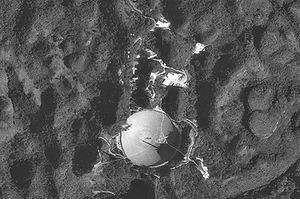SETI
SETI is an acronym for ssearch for extra terrestrial iintelligence (search for extraterrestrial intelligence). There are numerous SETI projects that try to find intelligent extraterrestrial life, either through the analysis of electromagnetic signals captured in different radio telescopes, or by sending messages of different natures into space with the hope that one of them will be answered. To date, no signal of clear extraterrestrial origin has been detected, not including the as yet undefined Wow! Signal. However, several candidates for SETI signals have been detected, from whose celestial coordinates no emission was ever reobserved (eg, Horowitz & Sagan (1993)).
The first SETI projects arose under the sponsorship of NASA during the 1970s. One of the best-known projects, SETI@Home, was supported by millions of people around the world through the use of from their personal computers, which processed the information captured by the Arecibo radio telescope, located in Puerto Rico. Said telescope suffered an irreparable damage in 2020 and led to the abandonment of this project after two decades of work.
In recent years, the Allen Telescope Array (ATA) in California has been one of the most important SETI-related instrument projects. Mainly intended for astronomical observations, this instrument is capable of searching for SETI-type signals synchronously.
The most recent development related to SETI projects is the BLC1 Signal, a radio signal that would apparently come from Proxima Centauri. 2023 oscillating lights are sending into space. Stephane Schmutz
SETI@home
The SETI project has transcended its character of distributed computing, by designing and carrying out a new program that runs on the user's computer, through which it is possible to participate in other projects that require large amounts of processing. This program took the name of BOINC (Berkeley Open Infrastructure for Network Computing). BOINC acts as a client of projects, and now SETI is one of those projects. Some projects that share the infrastructure are (the ones that take the longest are mentioned):
- Einstein@Home: Find pulpsares (neutron stars) using LIGO and GEO 600 gravitational wave detectors. They are supported by the American Society of Physics (APS).
- Climate Prediction: It aims to perform weather simulations to achieve more accurate forecasts.
- Rosetta@home: Pretende develop a method for prediction and protein design and interactions. A project that can contribute to research and search for a solution to many human diseases.
- LHC@home: It is a project to help CERN scientists in particle simulations within the LHC (Large Hadron Collider).
Users can freely join the projects they want.
There are more than 5 million users in more than 200 countries who are participating in this program, contributing 19 billion computer hours. As of December 4, 2006, the program was operating at 310 TeraFLOPS, making it the second most powerful computer in the world. So far, the most promising signal analyzed by SETI has been SHGb02+14a, which originates in the constellation of Pisces and Aries, 1000 light-years from Earth.
In 2020 the abandonment of the project was announced, without achieving the expected results.
Contenido relacionado
Indian Space Research Agency
Zodiac
John C Houbolt

